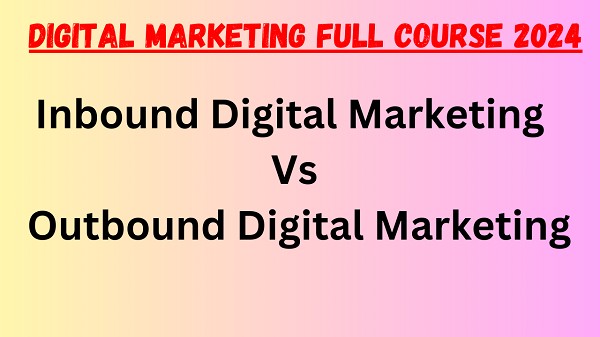Inbound and Outbound Digital Marketing
In the realm of digital marketing, two prominent strategies frequently dominate discussions: inbound digital and outbound digital marketing. These approaches both harness the power of digital platforms to engage audiences and drive results, but they operate in distinct ways. In this article, we’ll explore the concepts of inbound digital and outbound digital marketing, provide examples, and highlight their key differences.
Inbound Digital Marketing:
Inbound digital marketing is a customer-centric approach that focuses on attracting and engaging audiences by providing valuable and relevant content tailored to their needs and interests. It aims to pull prospects towards a brand organically, rather than interrupting them with intrusive advertisements. Inbound digital marketing strategies are geared towards building relationships, establishing authority, and earning the trust of potential customers.
Examples of Inbound Digital Marketing:
- Content Marketing: Creating blog posts, articles, videos, podcasts, and other forms of content that educate, entertain, or solve problems for your target audience. For example, a software company might create blog posts offering tips and tutorials on using their product effectively.
- Search Engine Optimization (SEO): Optimizing website content, metadata, and structure to improve visibility in search engine results pages (SERPs). An online retailer might optimize product pages to appear higher in search results for relevant keywords.
- Social Media Engagement: Building a strong presence on social media platforms and engaging with followers by sharing valuable content, responding to comments, and participating in conversations. A beauty brand might host live Q&A sessions on Instagram to interact with customers and showcase new products.
- Email Marketing: Sending personalized and targeted emails to subscribers with valuable content, promotions, or updates. A fitness studio might send out weekly newsletters with workout tips, healthy recipes, and class schedules.
- Inbound Advertising: Using non-disruptive advertising tactics such as sponsored content or native advertising to reach audiences in a more organic manner. A travel agency might create sponsored blog posts or videos featuring destination guides or travel tips.
Outbound Digital Marketing:
Outbound digital marketing, on the other hand, involves reaching out to audiences proactively and pushing promotional messages to them. While it still utilizes digital channels, outbound digital marketing tends to be more interruptive and less focused on building relationships. Instead, it aims to capture attention and generate immediate responses from potential customers.
Watch Our Live Class On Youtube by click on the below link
Examples of Outbound Digital Marketing:
- Display Advertising: Placing banner ads, pop-ups, or interstitial ads on websites or mobile apps to reach a wide audience. An e-commerce store might use display ads to promote a flash sale or new product launch.
- Paid Search Advertising: Bidding on keywords to display ads prominently in search engine results pages (SERPs). A software company might bid on terms related to their product to appear at the top of Google search results.
- Social Media Advertising: Running targeted ads on social media platforms to reach specific demographics or interest groups. A fashion brand might create sponsored posts on Facebook or Instagram to showcase their latest collection.
- Email Blasts: Sending mass emails to purchased or rented email lists to promote products, services, or special offers. An online course provider might send out email blasts to promote a limited-time discount on course enrollments.
- Cold Outreach: Initiating unsolicited contact with potential customers through methods like cold calling, cold emailing, or direct messaging on social media. A B2B software company might reach out to businesses via LinkedIn to offer a demo of their product.
Key Differences:
- Approach: Inbound digital marketing focuses on attracting audiences by providing value and building relationships, while outbound digital marketing involves pushing promotional messages to audiences.
- Engagement: Inbound digital marketing aims to engage audiences through relevant and valuable content, whereas outbound digital marketing is often more transactional and interruptive.
- Timing: Inbound digital marketing targets audiences who are actively seeking information or solutions, while outbound digital marketing reaches out to audiences regardless of their immediate interest.
In conclusion, both inbound digital and outbound digital marketing strategies have their place in a comprehensive digital marketing plan. Understanding the distinctions between these approaches and deploying them strategically can help businesses effectively reach and engage their target audiences in today’s digital landscape.
Also Check Our Latest Uploads
Freelance Digital Marketing | Digital Marketing Jobs

